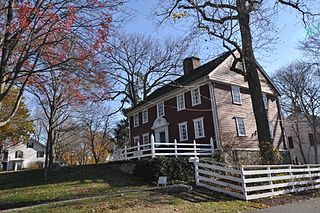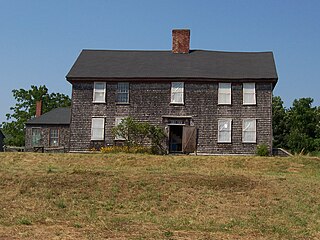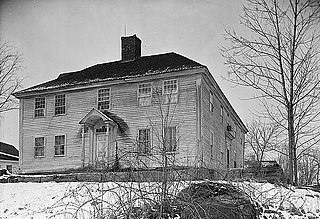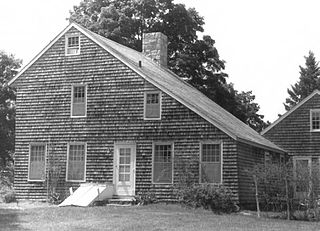
North Stonington is a town in New London County, Connecticut which was split off from Stonington in 1724. The town is part of the Southeastern Connecticut Planning Region. The population was 5,149 at the 2020 census.

The Stonington Harbor Light is a historic lighthouse built in 1840 and located on the east side of Stonington Harbor in the Borough of Stonington, Connecticut. It is a well-preserved example of a mid-19th century stone lighthouse. The light was taken out of service in 1889 and the building has served as a museum for the Stonington Historical Society since 1925. It was listed on the National Register of Historic Places in 1976.

The Mechanic Street Historic District encompasses a historic 19th-century mill and mill village in a 14-block area of the Pawcatuck section of Stonington, Connecticut. Extending along the Pawcatuck River and south of West Broad Street, the area includes a large brick mill complex on the banks of the river, and a neighborhood of well-preserved worker housing on the road grid to its west. The district was listed on the National Register of Historic Places in 1988.

The Captain David Judson House is a historic house at 967 Academy Hill in Stratford, Connecticut. It was built by David Judson in 1723. The new house was built on the stone foundation and incorporates the chimney of the original house built on the site in 1638 by Judson's great-grandfather William. William left the house to his son Joseph Judson in November 1660 when he removed to New Haven. Nine generations of Judsons lived in the house until 1888.

The Capt. Nathaniel B. Palmer House is a historic house museum in Stonington, Connecticut, built in 1852–54. The house is a transitional style between the Greek revival and the Victorian Italianate. It was built for Nathaniel Brown Palmer (1799–1877), who was a seal hunter, a pioneering Antarctic explorer, and a major designer of clipper ships. Threatened with demolition, it was acquired by the Stonington Historical Society in 1995, which operates it as a museum devoted to Palmer. The house was declared a National Historic Landmark in 1996.

The Stanton–Davis Homestead Museum is a historic house on Greenhaven Road in Stonington, Connecticut. It was built around 1700. The property has been a working farm for over 350 years, most by members of the Davis family. The property is currently in the process of being restored by the Stanton-Davis Society into a museum.

Norwichtown is a historic neighborhood in the city of Norwich, Connecticut. It is generally the area immediately north of the Yantic River between I-395 and Route 169.

Edward Townsend Mix was an American architect of the Gilded Age who designed many buildings in the Midwestern United States. His career was centered in Milwaukee, Wisconsin, and many of his designs made use of the region's distinctive Cream City brick.

The Jonathan Wheeler House is a historic house on North Society Road in Canterbury, Connecticut. Built c. 1760, it has features unusual for its time, including end chimneys and a center-hall plan. The use of brick in this part of rural Connecticut is also unusual for the period. The house was listed on the National Register of Historic Places in 1982.

The North Stonington Village Historic District is a 105-acre (42 ha) historic district encompassing the historic center of the main village of North Stonington, Connecticut. The district includes a well-preserved small industrial village, which flourished in the years before the American Civil War, and declined afterward. The district was listed on the National Register of Historic Places in 1983.

The Mystic Bridge Historic District is a historic district in the village of Mystic, Connecticut on the Stonington side of the Mystic River. It includes the Mystic Seaport Museum, whose grounds and floating vessels represent the area's history, and the 1924 Mystic River Bascule Bridge. The district is significant as a well-preserved shipbuilding and maritime village of the 19th and early 20th centuries, and it was added to the National Register of Historic Places in 1979.
The Mystic River Historic District encompasses the part of the village of Mystic, Connecticut that is on the Groton side of the Mystic River. The district was added to the National Register of Historic Places on August 24, 1979, approximately 235-acre (95 ha) which includes much of the village of West Mystic and many buildings from the 19th century.

The Whitehall Mansion is a historic house at 42 Whitehall Avenue in the Stonington side of Mystic, Connecticut. Built about 1771 for a local physician and politician, it is a fine example of late Georgian architecture. It has been moved twice, both times short distances, and now serves as a bed and breakfast inn. The house was added to the National Register of Historic Places on April 12, 1979.

The Samuel Miner House was a historic house on Hewitt Road in North Stonington, Connecticut. Built in 1717, it was a unique and rare example of a house that was constructed of apple, oak, sycamore and chestnut wood, The house was destroyed by fire in April 2003. with a particularly well-preserved late First Period bedchamber. It was listed on the National Register of Historic Places in 1976.

Leoni W. Robinson (1851-1923) was a leading architect in New Haven, Connecticut.

The Acors Barns House is located at 68 Federal Street at the corner of Meridian Street in New London, Connecticut. Barns was a wealthy merchant in the whaling industry whose company became one of the largest whaling firms in the city. He managed to avoid the collapse of whaling by investing elsewhere; he was the founder of the Bank of Commerce in 1852, and his son and grandson succeeded him as president.
Harold Erickson Kebbon Sr. was an American architect who designed over 100 schools as well as several post offices, courthouses, housing developments and private residences.

The Mystic Bank is a historic commercial building at 39 Main Street in the Old Mystic village of Stonington, Connecticut. Built in 1856 for a bank founded in 1833, it was used by the town as a meeting hall after the bank closed in 1884, and now houses offices. It is a good example of a small 19th-century Greek Revival brick bank building. It was listed on the National Register of Historic Places in 2014.

Stonington Cemetery is a historic cemetery at North Main Street and United States Route 1 in Stonington, Connecticut. Established as a family cemetery about 1754, it was the first formally incorporated cemetery in New London County, with the incorporation of its association occurring in 1849. Its layout is reflective of changing trends in cemetery organization, from colonial practices to those of the 20th century. It was listed on the National Register of Historic Places in 2018.

The Daniel Robert House is a historic house located at 25 West End Avenue in the borough of Somerville in Somerset County, New Jersey. The house was built in 1888 for Daniel Robert (1840–1908) by the architectural firm Lambert & Bunnell based on Gothic Revival style houses designed by the architect Alexander Jackson Davis. It now serves as the Somerville Borough Hall and the Somerville Public Library. The building was added to the National Register of Historic Places on March 5, 2008 for its significance in architecture from 1888 to 1939.




















